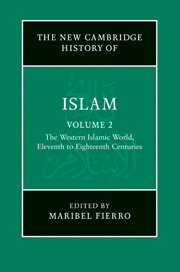Book contents
- Frontmatter
- Introduction
- PART I AL-ANDALUS AND NORTH AND WEST AFRICA (ELEVENTH TO FIFTEENTH CENTURIES)
- PART II EGYPT AND SYRIA (ELEVENTH CENTURY UNTIL THE OTTOMAN CONQUEST)
- PART III MUSLIM ANATOLIA AND THE OTTOMAN EMPIRE
- 10 The Turks in Anatolia before the Ottomans
- 11 The rise of the Ottomans
- 12 The Ottoman empire (tenth/sixteenth century)
- 13 The Ottoman empire: the age of ‘political households’ (eleventh–twelfth/seventeenth–eighteenth centuries)
- 14 Egypt and Syria under the Ottomans
- 15 Western Arabia and Yemen during the Ottoman period
- PART IV NORTH AND WEST AFRICA (SIXTEENTH TO EIGHTEENTH CENTURIES)
- PART V RULERS, SOLDIERS, PEASANTS, SCHOLARS AND TRADERS
- Glossary
- Bibliography
- Index
- References
11 - The rise of the Ottomans
from PART III - MUSLIM ANATOLIA AND THE OTTOMAN EMPIRE
Published online by Cambridge University Press: 28 March 2011
- Frontmatter
- Introduction
- PART I AL-ANDALUS AND NORTH AND WEST AFRICA (ELEVENTH TO FIFTEENTH CENTURIES)
- PART II EGYPT AND SYRIA (ELEVENTH CENTURY UNTIL THE OTTOMAN CONQUEST)
- PART III MUSLIM ANATOLIA AND THE OTTOMAN EMPIRE
- 10 The Turks in Anatolia before the Ottomans
- 11 The rise of the Ottomans
- 12 The Ottoman empire (tenth/sixteenth century)
- 13 The Ottoman empire: the age of ‘political households’ (eleventh–twelfth/seventeenth–eighteenth centuries)
- 14 Egypt and Syria under the Ottomans
- 15 Western Arabia and Yemen during the Ottoman period
- PART IV NORTH AND WEST AFRICA (SIXTEENTH TO EIGHTEENTH CENTURIES)
- PART V RULERS, SOLDIERS, PEASANTS, SCHOLARS AND TRADERS
- Glossary
- Bibliography
- Index
- References
Summary
The rise
The origins of the Ottomans are obscure. According to legend, largely invented later as part of the process of legitimising Ottoman rule and providing the Ottomans with a suitably august past, it was the Saljuq ruler ʿAlāʾ al-Dīn who bestowed rule on the Ottomans. The Saljuqs had however ceased to be the dominant power in Anatolia after their defeat by the Ilkhans, the Mongol rulers of Iran, at the battle of Köse Daǧ in 641/1243. Towards the end of the century the Ilkhans too no longer controlled the region effectively, while the other major regional power, the Byzantine empire, was a mere shadow of its former self, unable to maintain any strong hold over its territories to the east. It was out of this power vacuum that the Ottomans, like the other small Turkish states, emerged towards the end of the seventh/thirteenth century.
By 700/1300 Anatolia was peppered with Turkish states (begliks). In the west, spread out along the Aegean coast running north to south, lay the begliks of Qarasi, along the Dardanelles, Ṣarukhan, based round Maghnisa, Aydın, with its centre at Tire, and Menteshe, based round Balaṭ. Both Aydın and Menteshe had important trade relations with the Italian city-states, and from early in the eighth/fourteenth century concluded treaties with Venice, the earliest extant with Menteshe dating from 731/1331 and that with Aydın from the same year. To the south, round Anṭalya, lay Tekke, and inland, Ḥamid, round Isparta.
- Type
- Chapter
- Information
- The New Cambridge History of Islam , pp. 313 - 331Publisher: Cambridge University PressPrint publication year: 2010
References
- 2
- Cited by

